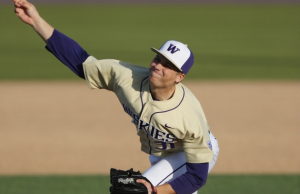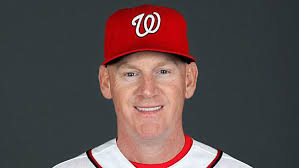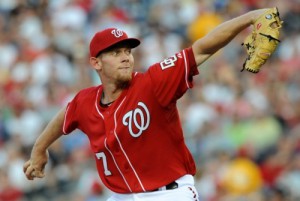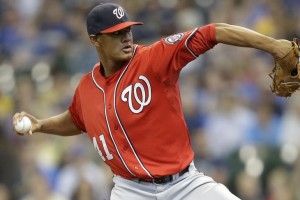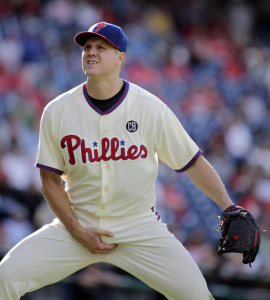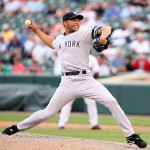The next in a series: previously we reviewed the 2015 season stats for the 2015 draft class and the 2014 draft class. Unlike these other two posts, this one was a bit easier to write. Why? Because I had done this analysis for the 2013 class previously … back in 2013. All I had to do was cut-n-paste that post and all 40 draftees were already listed with key details. Ahhh. I may continue this with previous classes since it was easier to compile. Hopefully I didn’t miss any obvious promotions for key guys like I did previously.
Web links to use while reading:
- Stats are pulled from milb.com and/or fangraphs.com; put the player name into the search bar to get his seasonal stats
- The MLB Draft Tracker (which I believe is the best draft tracker out there) is the best place to get draft class information.
- The Big Board and the Draft Tracker are the goto resources for prospects for any Nats fan.
- Baseball-reference.com’s draft database
- My working XLS in Google for all this data (cut-n-pasted at the bottom).
- TheBaseballCube.com for really obscure stats for players.
Without further ado:
Round 1: forfeited w/ Rafael Soriano signing, which as I noted in this June 2013 post cost the Nats a shot at one of several highly regarded pitchers drafted just behind our vacated spot. In retrospect, here’s a quick summary of the careers so far of the guys I liked at the time in that spot (Rob Kaminsky, Sean Manaea, Ryne Stanek, Ian Clarkin):
- Kaminsky: so far, looks pretty good. Career 2.22 ERA across multiple levels, finishing this year in High-A. Flipped this year to Cleveland from St. Louis (his drafting team) in the Brandon Moss deal.
- Manaea: looks awesome after some injury issues in 2013. Finished 2015 going 6-0 with a 1.93 ERA for Midland in AA and was a key prospect going to Oakland in the Ben Zobrist deal. I really liked him in 2013 and thought his hip injury bumped him down the line from being the top 10 talent he was initially projected to be, and nothing he’s done professionally has countered that.
- Stanek: dominated high-A for Tampa Bay this year, finished the year in AA.
- Clarkin: drafted by the Yankees, pitched his first full season of pro ball in low-A (impressive), giving Charleston 16 decent starts. Hurt his elbow in 2015 spring training and didn’t pitch all year, but is apparently recovered and is now pitching in the AFL.
I dunno. I hate to sound like a repeating record on the Soriano signing, but it looks even worse know knowing who we could have had. Knowing how Mike Rizzo loves college arms, you have to think he was likely looking at either Manaea or Stanek, and both those guys are looking like mid-rotation starters perhaps by mid 2016. All for an overpriced malcontent closer we didn’t need and who was eventually supplanted from the role by the same in-house option (Drew Storen) who the team AGAIN tried to supplant with another unnecessary over-priced malcontent (this time Jonathan Papelbon) in 2015 to disastrous results. Do you think Rizzo and Lerner have learned their lesson by now?
Back to the analysis.
Round 2: Jake Johansen, Coll Sr. RH Starting Pitcher Dallas Baptist U.. 1-7, 5.44 ERA with 48/27 K/BB in 48 relief IP, 4.69 fip, .358 babip for Potomac this year. He was pushed to the bullpen full time for 2015 yet was, frankly, awful in relief. This is on top of his 5.19 ERA in 2014 in Hagerstown. This pick is looking more and more like a disaster. I don’t see any silver linings here, other than his K/inning rate (which is thrown off by his 4.5 walks/9 inning rate for his career). Trending Down.
Round 3: Drew Ward, HS 3B. Slashed .249/.327/.358 with 110/39 K/BB in 377 Abs, 6hr for High-A Potomac. Missed a month with an injury, but otherwise took incremental steps back on his performance from his 2014 campaign in Low-A. Where’s the power? Slugging .358 isn’t great, especially for a corner infielder. But there doesn’t seem to be anyone else really preventing him from suiting up for Harrisburg as the starting 3B in 2016. Also worth remembering; he’s a HS draftee so he was a 20-yr old in High-A; quite young. That tempers any criticism. He’s in the Arizona Fall League, a good sign for the team’s opinion of him, so even my opinion may be slightly conservative. Trending Steady.
Round 4: Nick Pivetta, Juco RH Starting Pitcher. 7-4, 2.29 ERA for Potomac in 2015 before getting traded to Philadelphia for Jonathan Papelbon. Was working on a nice improvement over his 2014 campaign for Hagerstown (13-8, 4.22 ERA). Was bumped up to Philly’s AA affiliate in Reading PA and struggled to finish out 2015.
Round 5: Austin Voth, Coll Jr RH Starting Pitcher: 6-7, 2.92 ERA and 148/40 k/bb across 157 ip (28 starts) for AA Harrisburg. 3.07 fip, .284 babip. Another excellent campaign after his three-level jump in 2014. He’s now regularly mentioned in the back-end of Nats top 10 prospect lists and seems like he could be one of the first options considered in 2016 if a MLB starting pitcher gets injured. Looks like a steal of this draft and could be the best player to come out of it by the time all is said and done. Trending Up.
Round 6: Cody Gunter, Juco 3B: 1-0 4.15 ERA, 23/8 K/BB in 21.2 IP for Short-A Auburn, 3.84 fip, .259 babip. Gunter was drafted as a 3B and after two non-descript seasons in Auburn converted to the mound. so far, results look promising; he maintained a K/inning ratio with good control and could be better based on the ERA-FIP delta. I see him getting pushed to the Low-A bullpen in 2016. Trending Steady.
Round 7: Jimmy Yezzo, Coll Jr 1B. Slashed .192/.250/.256 with 36/13 K/BB in 49 games at Potomac, with just one homer, before the team pulled the plug and released him on 7/22/15. Yezzo showed some power in Low-A in 2014 (13 homers in 123 games) but clearly not enough to justify keeping him around as a 1B-only player. This was always going to be the jeopardy with drafting him; he was positionally limited from the start and, despite a great college campaign, couldn’t make the transition in pro ball. Immediately after his release he picked up with a Frontier League team, finishing out the season, so hopefully he gets another shot.
Round 8: David Napoli, Coll Sr LH relief pitcher. Went 7-5, 4.01 ERA with 62/36 K/BB in 60 relief IP mostly for LowA Hagerstown. 3.57 fip, .289 babip. He started with Potomac but spent most of the year in Hagerstown, despite turning 25 during the season. If anything, his numbers took a step back from his 2014 Hagerstown campaign, and given his age and the glut of arms in the system, time may be running out. Or maybe not: i mean, he signed for $15k and basically cost the team nothing and eats innings; that kind of guy is useful to have around. See McGregor, Scott for AAA the last couple of years. Trending Down.
Round 9: Jake Joyce, Coll Sr RH relief pitcher. Released in July 2014 as the 2014 signees started reporting to Vermont after just one season in Auburn where he posted a 5+ ERA. A cheap, senior sign who had to do more to impress and stick around as Napoli has done.
Round 10: Brennan Middleton, Coll Sr SS/2B. Slashed .198/.252/.264 for half a season while repeating LowA despite his age and was summarily released in July 2015. Senior sign, low bonus figure, poor performance all contributed.
Round 11: John Simms, Coll jr RH relief pitcher. 6-6, 2.74 ERA with 48/25 K/BB in 88.2 (15 starts) for Potomac. 4.15 fip, .236 babip. Earned a mid-season promotion and ended the season with 6 starts in Harrisburg’s rotation. Excellent season-over-season improvement for Simms, who will look to do the same thing in AA’s rotation for 2016. The team clearly sees the same potential and sent him to the Arizona Fall League this year. Trending up.
Round 12: Andrew Cooper, Juco RH relief pitcher. 2-2, 3.53 ERA with 35/16 K/BB in 63.2 relief IP for LowA Hagerstown, 3.63 fip, .283 babip. Improved his numbers across the board while repeating LowA. Still isn’t getting the K/9 we’d like to see though. He’ll be 24 in High-A next year in what probably is a make or break season. Trending Steady.
Round 13: John Costa, Juco RH relief pitcher. Released 4/1/15 after being injured most of 2014. Without knowing the details, I’d guess that whatever injury he suffered was a career ender, that he couldn’t show enough improvement in spring training 2015 to merit keeping around. Tough break.
Round 14: David Masters, Juco SS. Slashed .226/.311/.285 with 69/40 K/BB in 354 Abs, 2hr, 3SB mostly in LowA, missed most of May and June. Did earn a promotion to HighA in August to finish out the season. With so many MIF in the system and the likes of Chris Bostick blasting homers in the AFL, Masters may not be long for the organization. Trending down.
Round 15: Isaac Ballou, Coll Sr OF/CF. Slashed .271/.344/.397 with 82/47 K/BB in 431 Abs, 8homers 21steals CF/LF as he jumped two levels (from HighA to AAA) in 2015. A nice season from the local product (hails from Germantown, MD, went to Marshall U). An .876 OPS in AA greased the skids for him to move up the line. He has some speed (56 career SBs in 322 games) and can hit and can play all three OF positions; can he push the likes of Matt den Dekker for a utility OF spot on the big club? Maybe not for 2016, but a strong AAA campaign would help. Trending up.
Round 16: Willie Allen, Juco Corner OF from Oklahoma/Newtown, MA. Did not sign; transferred to Lewis-Clark State (ID). Allen was an odd case at the time; it was literally impossible to find information on him. But he’s definitely playing college ball at Lewis-Clark now. Now known as “William Allen” if you’re trying to find him in various databases, fyi.
Round 17: Geoff Perrott, Coll Sr C. released/retired (2015): never played in 2014 and no record of his official release in milb.com, but clearly he’s done playing.
Round 18: Cory Bafidis, Coll Sr LH relief pitcher. Released July 2014 once the 2014 draftees started showing up in Auburn. This release has troubled me; he had decent numbers in 2013, then got axed after just 6 innings in 2014. Seemed too fast to me.
Round 19: Niko Spezial, Coll Sr LH relief pitcher. Released in May of 2014, even before the draft. Only threw 19 innings in 2013 and none in 2014, not getting a full-team assignment and likely just losing out on the anticipated numbers game.
Round 20: Brenton Allen, Coll Jr Corner OF. As with Bafidis, Released in June 2014 once the 2014 draftees started showing up in Auburn. He only hit .197 in Auburn in 2013 and was clearly replaceable with new 2014 OF draftees.
Round 21: Justin Thomas, Coll Sr LH relief pitcher. 1-6, 3.43 ERA with 50/18 K/BB in 57.2 relief ip for Potomac. 2.84 fip, .300 babip in HighA. Oddly, he’s a lefty but he has much better L-R splits than loogy splits. But, he also wasn’t really used as a loogy, accumulating 57 innings in 28 games. He was more of a swing-man/innings sponge for the team despite never getting an official start. Good peripherals, good K/9 rates, I see him moving up to the AA bullpen easily. Nice find in the 21st round. Trending up.
Round 22: Cody Dent, Coll Sr SS. Slashed .193/.257/.224 with 42/12 K/BB in 161 abs, 1hr, 2sb, mostly in LowA. Played 3B, got moved up to HighA and then went 0-24 in Potomac. He didn’t play after 7/31 but did not appear on any injury report; he was on the TIL for basically the rest of the season. The son of Bucky Dent seems to be getting similar treatment as Ryan Ripken and Cutter Dykstra (also sons of former MLBers); he’s hanging around despite poor numbers. How long can it last with all the MIF options moving up the line? Trending down.
Round 23: Garrett Gordon, Juco Corner OF. Released in March of 2015; hit just .230 in Auburn in 2014 as a corner OF and, as with Allen above, was deemed replaceable with the 2015 crop of players rising up.
Round 24: Matt DeRosier, Juco RH relief pitcher. 0-2, 3.58 ERA with 30/7 K/BB in 27IP (7 starts) mostly in the GCL, having gotten dumped out of Auburn after a couple of poor starts. 2.02 fip, .435 babip in Auburn, so perhaps it was a short-sample-size that was unflattering. He needs to put together a nice string of healthy starts somewhere outside of complex ball though. Trending down.
Round 25: Travis Ott, HS LH starting pitcher. Traded 12/17/14 along with Steven Souza in the Trea Turner/Joe Ross deal. Despite his sterling short-A 2014 season, Tampa had him repeat the NY Penn league, where he was 6-3 with a 3.90 ERA in 13 starts. Odd.
Round 26: Garrett Hampson, HS SS from Reno, NV. Did not sign; honored commitment to Long Beach State.
Round 27: Bryce Harmon, HS LH starting pitcher from Richmond, VA. Did not sign; honored commitment to East Carolina University.
Round 28: Joey Webb, Coll Sr LH relief pitcher. Released 6/25/15, losing out in the numbers game when the 2015 short-season college draftees started flowing in.
Round 29: Mike Sylvestri, Coll Sr RH relief pitcher. Retired on 6/13/14 after struggling in low-A.
Round 30: Ryan Ullmann, Coll Sr RH Starting pitcher. Released 6/25/15, in a similar fashion to Webb above.
Round 31: Willie Medina, Coll Sr SS. Released in Jan 2015 after a mediocre season between LowA and ShortA in 2014.
Round 32: Pat Boling, Coll Jr LHP: Did not sign, chose to return to U. of Georgia for his senior season. It does not look like Boling was re-drafted, nor does it appear he played any independent ball.
Round 33: Andrew Dunlap, HS C/RHP from Houston. Did not sign. Honoring a commitment to Rice University.
Round 34: Jake Walsh, Coll Sr LH relief pitcher. 2-1, 1.96 ERA, 32/14 K/BB across 36ip as he was promoted from LowA->HighA. 3.51 fip, .273 babip in Potomac. After starting the 2015 season with 17 scoreless innings for Hagerstown, he got bumped up and spent the rest of the season there. Despite his lowly draft status, Walsh has now impressed at every stop and owns a career 1.65 ERA across the various Rookie/A-ball levels. Maybe its time to give this guy a shot at AA? At the very least he looks like a left-handed specialist in training. Trending up.
Round 35: Lukas Schiraldi, Juco RHP from Texas. Did not sign; instead transferred to U Texas. Drafted in 2014 in the 15th round by Seattle, but he has since struggled as a low-A starter, with two straight seasons of 5+ ERA.
Round 36: Reid Humphreys, HS SS from Missouri. Did not sign. Honoring commitment to Mississippi State.
Round 37: Karsten Whitson, RH starting pitcher from Florida. Did not sign, returning to U Florida for his senior/4th year. There’s plenty of cautionary stories about Whitson, who turned down 1st round money and eventually was drafted by Boston in 2014 as an 11th rounder (likely bonus; max of $100k). His pro season looks like its a struggle right now; he had just 7IP in 2014, and was listed as “inactive” for all of 2015. Hate to see such a promising arm apparently fizzle out.
Round 38: Caleb Hamilton, HS SS from Washington State. Did not sign; honoring commitment to U of Washington.
Round 39: Robbie Tenerowicz, HS 2B/SS from California. Did not sign; honoring commitment to UC Berkeley. Washington sure loves 2nd basement from Cal-Berkeley, doesn’t it? See Tony Renda in 2012 or Jeff Kobernus in 2009. I’m sure we’ll revisit Tenerowicz when the time is right.
Round 40: Shaun Anderson, HS RH starting pitcher from Florida. Did not sign; honoring commitment to U of Florida.
Trending Summary:
- Trending Up (5): Voth, Simms, Ballou, Thomas, Walsh
- Trending Steady (3): Ward, Gunter, Cooper
- Trending Down (5): Johanssen, Napoli, Masters, Dent, Derosier
- Did Not Sign in 2013 (11): Allen, Hampson, Harmon, Boling, Dunlap, Schiraldi, Humphries, Whitson, Hamilton, Tenerowicz, Anderson
- Released/Retired (13): Yezzo, Joyce, Middleton, Costa, Perrott, Bafidis, Spezial, Allen, Gordon, Webb, Sylvestri, Ullmann, Medina
- Traded (2): Pivetta, Ott
Executive Summary
The 2013 class is being whittled down quickly; of the 39 initial names, 11 never signed and another 13 have already been cut loose. That only leaves 15 guys to draw conclusions from. I think its safe to say the loss of the 1st rounder and the failures of our 2nd rounder severely dampen this draft, but Voth and Simms give us some promise. I also like what we’re seeing out of long-shots Thomas and Walsh, with some lingering hope that the youngster Ward could make the leap. Meanwhile, two important names out of this draft (Pivetta and Ott) were used to acquire important players; especially Ott’s role in acquiring two every day players of the planned 2016 25-man roster.
cut-n-paste of Working XLS of data:
| Round | Player/Pos | Level | 2015 Level | 2015 Basic Stats |
| 2 | Johansen, Jake RHP | COL sr | Potomac | 1-7, 5.44 ERA |
| 3 | Ward, Drew 3B | HS (3) | Potomac | .249/.327/.358 |
| 4 | Pivetta, Nicholas RHP ** | JUCO | Traded (2015) | |
| 5 | Voth, Austin RHP | COL jr | Harrisburg | 6-7, 2.92 ERA |
| 6 | Gunter, Cody 3B | JUCO | Short-A | 1-0 4.15 ERA |
| 7 | Yezzo, James 1B | COL jr | released (2015) | |
| 8 | Napoli, David LHP | COL sr | LowA | 7-5, 4.01 ERA |
| 9 | Joyce, Jake RHP | COL sr | released (2014) | |
| 10 | Middleton, Brennan SS | COL sr | released (2015) | |
| 11 | Simms, John RHP | COL jr | Potomac | 6-6, 2.74 ERA |
| 12 | Cooper, Andrew RHP | JUCO | LowA | 2-2, 3.53 ERA |
| 13 | Costa, John RHP | CC | released (2015) | |
| 14 | Masters, David SS | JUCO | High-A->LowA | .226/.311/.285 |
| 15 | Ballou, William (Isaac) CF | COL sr | HighA->AA->AAA | .271/.344/.397 |
| 16 | Allen, Willie CF | JUCO | did not sign: Lewis-Clark State (ID) | |
| 17 | Perrott, Geoffrey C | COL sr | released/retired (2015) | |
| 18 | Bafidis, Cory LHP | COL sr | released (2014) | |
| 19 | Spezial, Niko LHP | COL sr | released (2014) | |
| 20 | Allen, Brenton LF | COL jr | released (2014) | |
| 21 | Thomas, Justin LHP | COL sr | Potomac | 1-6, 3.43 ERA |
| 22 | Dent, Cody SS | COL sr | LowA mostly | .193/.257/.224 |
| 23 | Gordon, Garrett RF | JUCO | released (2015) | |
| 24 | Derosier, Matthew RHP | JUCO | GCL->ShortA | 0-2, 3.58 ERA |
| 25 | Ott, Travis LHP* | HS | traded (2015) | |
| 26 | Hampson, Garrett SS | HS | did not sign: Long Beach St. | |
| 27 | Harman, Bryce RF | HS | did not sign: East Carolina | |
| 28 | Webb, Joey LHP | COL sr | released (2015) | |
| 29 | Sylvestri, Michael RHP | COL sr | retired (2014) | |
| 30 | Ullmann, Ryan RHP | COL sr | released (2015) | |
| 31 | Medina, Willie SS | COL sr | released (2015) | |
| 32 | Boling, Pat LHP | COL jr | did not sign: Georgia | |
| 33 | Dunlap, Andrew RHP | NA | did not sign: Rice | |
| 34 | Walsh, Jake LHP | COL sr | LowA->HighA | 2-1, 1.96 ERA |
| 35 | Schiraldi, Lukas RHP | JUCO | did not sign: Texas | |
| 36 | Humphreys, Reid SS | HS | did not sign: Mississippi State | |
| 37 | Whitson, Karsten RHP | COL jr | did not sign: Florida | .248/.307/.376 |
| 38 | Hamilton, Caleb SS | HS | did not sign: U of Washington | |
| 39 | Tenerowicz, Robbie 2B | HS | did not sign: UC Berkeley | |
| 40 | Anderson, Shaun RHP | HS | did not sign: Florida | 1-2, 5.45 |
